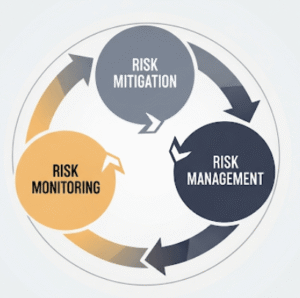- Metrics for Process and Products
- Software measurement
- Metrics for Software Quality
- Risk Management
- Reactive versus Proactive Risk Strategies
- Software Risks
- Risk Identification
- Risk Projection
- Risk Refinement
- RMMM
- RMMM Plan
- Quality Management
- Quality Concepts
- Software Reviews
- Formal Technical Reviews
- Statistical Software Quality Assurance
- Software Reliability
- The ISO 9000 Quality Standards
Introduction to RMMM
In software engineering, after identifying, projecting, and refining risks, the crucial next step is to actively manage them. This systematic approach is encapsulated by RMMM, which stands for Risk Mitigation, Monitoring, and Management. The RMMM framework provides a structured method for dealing with identified risks effectively. It involves developing strategies to reduce the impact or likelihood of risks (mitigation), keeping a close watch on the status of risks and mitigation efforts (monitoring), and consistently overseeing the entire risk process (management). Ultimately, RMMM is essential for ensuring that potential problems do not derail a software project, thereby contributing significantly to its overall success.
Components of RMMM
The RMMM framework is composed of three interconnected activities, each playing a vital role in comprehensive risk handling.
Risk Mitigation
Risk mitigation focuses on developing strategies to reduce the probability of a risk occurring or to lessen its impact if it does occur. This is the proactive part of RMMM, where plans are formulated to prevent or minimize negative consequences. For every significant risk, a mitigation strategy should be devised.
Examples of risk mitigation strategies include:
- For high staff turnover: Offering competitive salaries, providing professional growth opportunities, improving team morale, or developing a strong knowledge transfer process to minimize impact when someone leaves.
- For unclear requirements: Implementing rigorous requirements elicitation techniques, involving customers actively, and creating detailed prototypes.
- For technical challenges with new technology: Conducting pilot projects, investing in specialized training, or consulting with external experts.
A robust mitigation plan addresses the risk head-on before it becomes a problem.
Risk Monitoring
Risk monitoring involves continuously tracking the identified risks and the effectiveness of the implemented mitigation actions. This ongoing activity ensures that the risk management plan remains relevant and responsive to changes in the project environment. It includes:
- Tracking Risk Status: Regularly checking if known risks have changed in probability or impact, or if new risks have emerged.
- Assessing Mitigation Effectiveness: Evaluating whether the mitigation strategies are working as intended.
- Identifying Trigger Events: Recognizing specific conditions or events that signal a risk is about to occur. These triggers act as early warning indicators.
- Periodic Reviews: Conducting regular risk review meetings with the project team and stakeholders to discuss the current risk landscape.
Risk Management
Risk management encompasses the overall process of overseeing all risk activities throughout the project lifecycle. It involves making decisions about how to respond to risks, allocating resources for risk handling, and ensuring that the risk management process itself is effective. This component includes:
- Decision-Making: Determining whether to avoid, transfer, mitigate, or accept a risk.
- Resource Allocation: Assigning personnel, budget, and time for risk mitigation and monitoring activities.
- Contingency Planning: Developing backup plans (contingencies) for risks that cannot be fully mitigated and still pose a threat. This ensures a fallback strategy if a risk materializes despite mitigation efforts.
- Communication: Ensuring all stakeholders are aware of significant risks and the plans to address them.
- Continuous Improvement: Regularly reviewing and improving the overall risk management process based on lessons learned from past projects

The Importance of RMMM in Software Projects
Implementing a robust RMMM framework is crucial for the success of software projects. It helps in:
- Reducing Uncertainty: By systematically addressing risks, the overall uncertainty in a project is significantly reduced.
- Minimizing Impact: When risks are proactively managed, their potential negative impact on project objectives is minimized.
- Improving Project Predictability: Consistent monitoring and management lead to better predictability of project outcomes.
- Enhancing Decision-Making: RMMM provides data-driven insights that support more informed project decisions.
- Fostering Confidence: A well-managed risk process builds confidence among stakeholders and the project team.
Conclusion
RMMM (Risk Mitigation, Monitoring, and Management) is an indispensable framework for handling uncertainties in software engineering. By systematically planning to reduce risk impacts (mitigation), continuously tracking their status (monitoring), and making informed decisions throughout the project (management), organizations can navigate the complexities of software development more effectively. This comprehensive and proactive approach ensures that potential problems are addressed before they escalate, thereby significantly enhancing the likelihood of delivering successful, high-quality software products on time and within budget.
